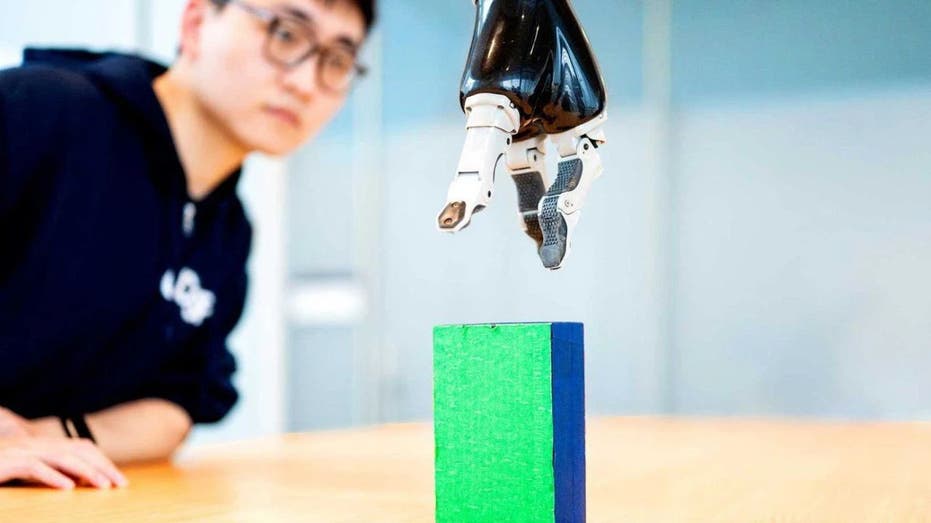
People with paralysis can control robotic devices through thought alone. Researchers at UC San Francisco have achieved a remarkable breakthrough in brain-computer interface (BCI) technology, enabling individuals with paralysis to control robotic devices through thought alone. This innovation combines artificial intelligence (AI) with neuroscience, allowing a paralyzed man to manipulate a robotic arm by imagining movements, a feat that marks a significant milestone in restoring autonomy to people with severe motor impairments.
Brain-computer interface (BCI) technology (UC San Francisco) The brain-computer interface: A new era of control The device, known as a brain-computer interface (BCI), represents a fusion of advanced AI and neural engineering. BCIs have previously struggled to maintain functionality over extended periods, often losing effectiveness after just one or two days. However, the newly developed BCI has set a record by functioning seamlessly for seven months without requiring major adjustments.

STAY PROTECTED & INFORMED! GET SECURITY ALERTS & EXPERT TECH TIPS — SIGN UP FOR KURT’S THE CYBERGUY REPORT NOW The key lies in the AI model’s ability to adapt to subtle changes in brain activity over time. As individuals repeatedly imagine movements, the AI refines its understanding of these neural signals, enabling more precise control of robotic devices. Dr.
Karunesh Ganguly, neurologist and professor at UCSF, emphasized that this adaptive learning between humans and AI is critical for achieving lifelike functionality in neuroprosthetics. WHAT IS ARTIFICIAL INTELLIGENCE (AI)? Brain-computer interface technology (UC San Francisco) EXOSKELETON HELPS PARALYZED PEOPLE REGAIN INDEPENDENCE Understanding brain changes: The science behind the breakthrough Dr. Ganguly’s research revealed that while the shape of brain activity representations remains consistent, their locations shift slightly from day to day.
This discovery explains why previous BCIs quickly lost their ability to interpret neural signals accurately. To address this challenge, Ganguly and his team studied a participant who had been paralyzed by a stroke years earlier. Sensors implanted on the surface of his brain recorded neural signals as he imagined movements like grasping or lifting objects.
Over two weeks, these signals were used to train the AI model to account for daily shifts in brain activity patterns. HOW TO REMOVE YOUR PRIVATE DATA FROM THE INTERNET Brain-computer interface technology (UC San Francisco) HOW ELON MUSK’S NEURALINK BRAIN CHIP WORKS From virtual practice to real-world success Initially, the participant practiced controlling a virtual robotic arm that provided feedback on his imagined movements. This training helped refine his ability to visualize precise actions.
Once he transitioned to using a real robotic arm, he quickly mastered tasks such as picking up blocks, opening cabinets and even holding a cup under a water dispenser. Months later, the participant retained his ability to control the robotic arm with minimal recalibration, highlighting the long-term reliability of this BCI system. GET FOX BUSINESS ON THE GO BY CLICKING HERE Brain-computer interface technology (UC San Francisco) THIS MIND-READING TECH USING AI CAN CONVERT BRAIN ACTIVITY INTO TEXT Implications for people with paralysis This groundbreaking technology has profound implications for individuals with paralysis.
Tasks like feeding oneself or accessing water independently could drastically improve quality of life. Dr. Ganguly is optimistic about refining the AI further to enhance speed and fluidity in movement while testing the system in home environments.
SUBSCRIBE TO KURT’S YOUTUBE CHANNEL FOR QUICK VIDEO TIPS ON HOW TO WORK ALL OF YOUR TECH DEVICES Brain-computer interface technology (UC San Francisco) Kurt's key takeaways The integration of adaptive AI into BCIs marks an exciting new chapter in neuroprosthetics, offering hope for millions living with paralysis worldwide. With continued advancements, these systems could soon restore essential functions and independence, transforming lives in ways once thought impossible. As AI-powered brain-computer interfaces begin to offer new independence to individuals with paralysis, what do you think are the most important next steps in developing these technologies to improve daily life for those affected? Let us know by writing us at Cyberguy.
com/Contact CLICK HERE TO GET THE FOX NEWS APP For more of my tech tips and security alerts, subscribe to my free CyberGuy Report Newsletter by heading to Cyberguy.com/Newsletter Ask Kurt a question or let us know what stories you'd like us to cover Follow Kurt on his social channels Facebook YouTube Instagram Answers to the most asked CyberGuy questions: What is the best way to protect your Mac, Windows, iPhone and Android devices from getting hacked? What is the best way to stay private, secure and anonymous while browsing the web? How can I get rid of robocalls with apps and data removal services? How do I remove my private data from the internet? New from Kurt: Try CyberGuy's new games (crosswords, word searches, trivia and more!) CyberGuy’s Exclusive Coupons and Deals Copyright 2025 CyberGuy.com.
All rights reserved. Kurt "CyberGuy" Knutsson is an award-winning tech journalist who has a deep love of technology, gear and gadgets that make life better with his contributions for Fox News & FOX Business beginning mornings on "FOX & Friends." Got a tech question? Get Kurt’s free CyberGuy Newsletter, share your voice, a story idea or comment at CyberGuy.
com..














